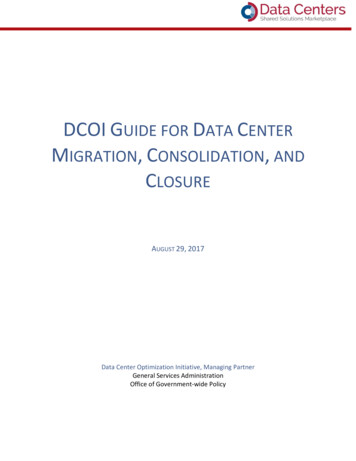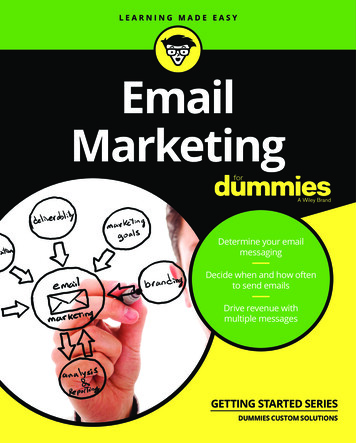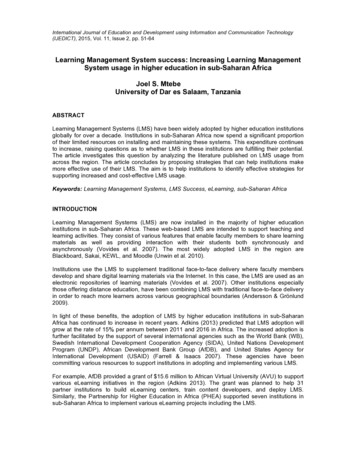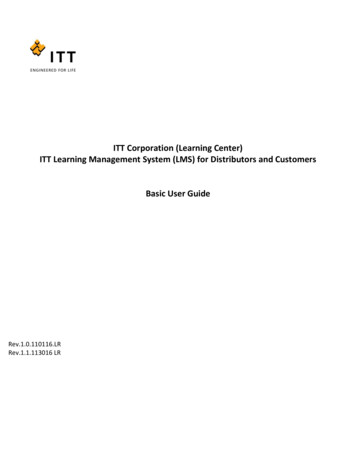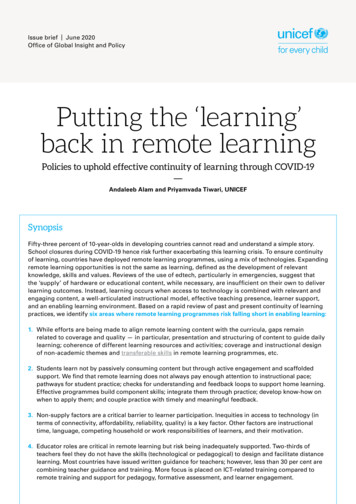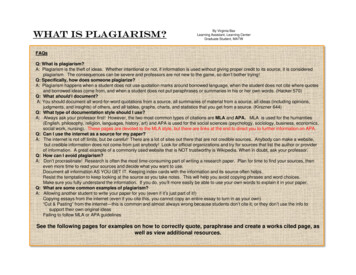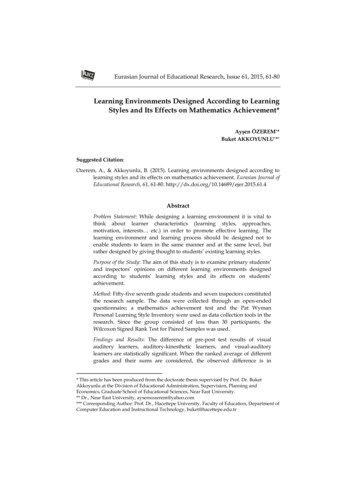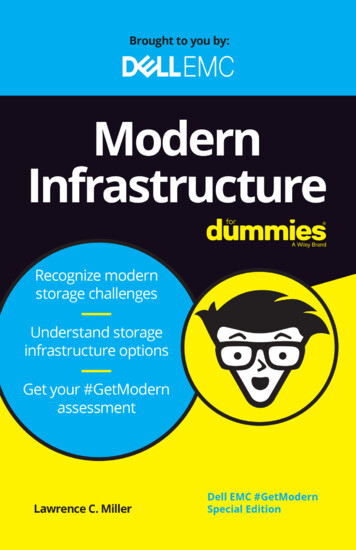
Transcription
These materials are 2020 John Wiley & Sons, Inc. Any dissemination, distribution, or unauthorized use is strictly prohibited.
DCOIThese materials are 2020 John Wiley & Sons, Inc. Any dissemination, distribution, or unauthorized use is strictly prohibited.
DCOINlyte 2nd Special Editionby Lawrence MillerThese materials are 2020 John Wiley & Sons, Inc. Any dissemination, distribution, or unauthorized use is strictly prohibited.
DCOI For Dummies , Nlyte 2nd Special EditionPublished byJohn Wiley & Sons, Inc.111 River St.Hoboken, NJ 07030-5774www.wiley.comCopyright 2020 by John Wiley & Sons, Inc., Hoboken, New JerseyNo part of this publication may be reproduced, stored in a retrieval system or transmitted in anyform or by any means, electronic, mechanical, photocopying, recording, scanning or otherwise,except as permitted under Sections 107 or 108 of the 1976 United States Copyright Act, without theprior written permission of the Publisher. Requests to the Publisher for permission should beaddressed to the Permissions Department, John Wiley & Sons, Inc., 111 River Street, Hoboken, NJ07030, (201) 748-6011, fax (201) 748-6008, or online at http://www.wiley.com/go/permissions.Trademarks: Wiley, For Dummies, the Dummies Man logo, The Dummies Way, Dummies.com,Making Everything Easier, and related trade dress are trademarks or registered trademarks of JohnWiley & Sons, Inc. and/or its affiliates in the United States and other countries, and may not beused without written permission. All other trademarks are the property of their respective owners.John Wiley & Sons, Inc., is not associated with any product or vendor mentioned in this book.LIMIT OF LIABILITY/DISCLAIMER OF WARRANTY: THE PUBLISHER AND THE AUTHOR MAKE NOREPRESENTATIONS OR WARRANTIES WITH RESPECT TO THE ACCURACY OR COMPLETENESS OFTHE CONTENTS OF THIS WORK AND SPECIFICALLY DISCLAIM ALL WARRANTIES, INCLUDINGWITHOUT LIMITATION WARRANTIES OF FITNESS FOR A PARTICULAR PURPOSE. NO WARRANTYMAY BE CREATED OR EXTENDED BY SALES OR PROMOTIONAL MATERIALS. THE ADVICEAND STRATEGIES CONTAINED HEREIN MAY NOT BE SUITABLE FOR EVERY SITUATION. THISWORK IS SOLD WITH THE UNDERSTANDING THAT THE PUBLISHER IS NOT ENGAGED INRENDERING LEGAL, ACCOUNTING, OR OTHER PROFESSIONAL SERVICES. IF PROFESSIONALASSISTANCE IS REQUIRED, THE SERVICES OF A COMPETENT PROFESSIONAL PERSON SHOULD BESOUGHT. NEITHER THE PUBLISHER NOR THE AUTHOR SHALL BE LIABLE FOR DAMAGES ARISINGHEREFROM. THE FACT THAT AN ORGANIZATION OR WEBSITE IS REFERRED TO IN THIS WORKAS A CITATION AND/OR A POTENTIAL SOURCE OF FURTHER INFORMATION DOES NOT MEANTHAT THE AUTHOR OR THE PUBLISHER ENDORSES THE INFORMATION THE ORGANIZATIONOR WEBSITE MAY PROVIDE OR RECOMMENDATIONS IT MAY MAKE. FURTHER, READERSSHOULD BE AWARE THAT INTERNET WEBSITES LISTED IN THIS WORK MAY HAVE CHANGED ORDISAPPEARED BETWEEN WHEN THIS WORK WAS WRITTEN AND WHEN IT IS READ.ISBN 978-1-119-68158-8 (pbk); ISBN 978-1-119-68147-2 (ebk)Manufactured in the United States of America10 9 8 7 6 5 4 3 2 1For general information on our other products and services, or how to create a custom ForDummies book for your business or organization, please contact our Business DevelopmentDepartment in the U.S. at 877-409-4177, contact info@dummies.biz, or visit www.wiley.com/go/custompub. For information about licensing the For Dummies brand for products or services,contact BrandedRights&Licenses@Wiley.com.Publisher’s AcknowledgmentsSome of the people who helped bring this book to market include thefollowing:Project Editor: Elizabeth KuballAssociate Publisher:Katie MohrEditorial Manager:Rev MengleBusiness DevelopmentRepresentative: Karen HattanProduction Editor:Magesh ElangovanSpecial Help: Michael SchmittThese materials are 2020 John Wiley & Sons, Inc. Any dissemination, distribution, or unauthorized use is strictly prohibited.
Table of ContentsINTRODUCTION. 1About This Book. 1Foolish Assumptions. 2Icons Used in This Book. 2Beyond the Book. 3CHAPTER 1:Assessing the Current State of the DCOI. 5Covering the Basics of the DCOI. 5Understanding the Goals of the DCOI. 7Closing as many existing data centers as possible. 7Consolidating data centers. 8Optimizing existing data centers. 8Lowering costs of existing data centersand avoiding new costs. 9Reviewing the Key Components of a DCOI Implementation. 9Evaluating the DCOI Track Record: A Scorecard. 10CHAPTER 2:Extending the Scope of the DCOI. 13Exploring the Three Pillars of Government Data Centers. 13The DCOI. 13Application Rationalization. 14Cloud Smart. 16Tackling the Three Pillars as a Unified Initiative. 18CHAPTER 3:Understanding the Key Componentsof the DCOI. 19Making the Most of New and Existing Data Centers. 19Automating Infrastructure Management. 20Tracking Performance Metrics. 22Virtualization. 22Advanced energy metering. 23Server utilization. 24Availability. 26Table of ContentsvThese materials are 2020 John Wiley & Sons, Inc. Any dissemination, distribution, or unauthorized use is strictly prohibited.
CHAPTER 4:Addressing the DCOI Requirementswith DCIM Software. 29Complying with the DCOI Mandates. 29Defining DCIM Software. 30Looking at DCIM software components. 30Aligning DCIM software to the DCOI mandates. 33Extending DCIM Software to the Modernizationand Optimization Pillars. 36CHAPTER 5:viTen (Or So) Questions to Ask a DCIM Vendor. 39DCOI For Dummies, Nlyte 2nd Special EditionThese materials are 2020 John Wiley & Sons, Inc. Any dissemination, distribution, or unauthorized use is strictly prohibited.
IntroductionInitially mandated for completion by the end of fiscal year 2018,the Data Center Optimization Initiative (DCOI) has beenextended to the end of fiscal year 2020 and is now part of abroader government initiative known as Cloud Smart. The updatedDCOI mandate, along with the Cloud Smart and ApplicationRationalization executive orders, form the three pillars of government modernization and optimization.Data centers throughout the federal government must comply with the optimization mandates set out in the DCOI, whichincludes the requirement to use data center infrastructure management (DCIM) software in agency data centers. However, notall DCIM software packages are alike. In fact, in many cases, theyaren’t even close to being comparable. You need to know what tolook for in a DCIM package to make sure you get the one that bestmeets your agency’s needs.About This BookDCOI For Dummies consists of five chapters that explain thefollowing:»» The current state of the DCOI and what’s been achieved sofar (Chapter 1)»» The three pillars of agency data centers: the DCOI, CloudSmart, and Application Rationalization (Chapter 2)»» What the DCOI is looking for in a data center and what datacenter management needs to do to comply with therequirements that the DCOI lays out (Chapter 3)»» What DCIM software is, how it helps agencies address therequirements of the DCOI, and how to extend its functionality to Cloud Smart and Application Rationalization (Chapter 4)»» Important questions you need to ask when evaluating theofferings of DCIM vendors that want to assist you in meetingthe goals set out by the DCOI (Chapter 5)Introduction1These materials are 2020 John Wiley & Sons, Inc. Any dissemination, distribution, or unauthorized use is strictly prohibited.
Each chapter is written to stand on its own, so if you see a topicthat piques your interest feel free to jump ahead to that chapter.You can read this book in any order that suits you (though I don’trecommend upside down or backward).Foolish AssumptionsIt has been said that most assumptions have outlived theiruselessness, but I assume a few things nonetheless. Mainly,I assume that at least one of the following applies to you:»» You’re involved in making decisions about how to complywith the DCOI.»» You’re a senior agency manager, responsible for an agency’sdata centers.»» You’re concerned about how the DCOI will affect youragency.If any of these assumptions describes you, then this is the bookfor you! If none of these assumptions describes you, keep readinganyway. It’s a great book and when you finish reading it, you’llhave a “deep state” of awareness about the DCOI mandate!Icons Used in This BookThroughout this book, I occasionally use special icons to callattention to important information. Here’s what to expect:This icon points out important information you should committo your nonvolatile memory, your gray matter, or your noggin —along with anniversaries and birthdays!Tips are appreciated, never expected — and I sure hope you’llappreciate these useful nuggets of information.These alerts point out the stuff your mother warned you about.Well, probably not, but they do offer practical advice to help youavoid potentially costly or frustrating mistakes.2DCOI For Dummies, Nlyte 2nd Special EditionThese materials are 2020 John Wiley & Sons, Inc. Any dissemination, distribution, or unauthorized use is strictly prohibited.
Beyond the BookThere’s only so much I can cover in 48 pages, so if youfind yourself at the end of this book, thinking, “Gosh, thiswas an amazing book! Where can I learn more?,” just go troduction3These materials are 2020 John Wiley & Sons, Inc. Any dissemination, distribution, or unauthorized use is strictly prohibited.
IN THIS CHAPTER»» Getting to know the DCOI»» Defining the goals of the DCOI»» Looking at the key components ofthe DCOI»» Assessing the DCOI progress to dateChapter1Assessing the CurrentState of the DCOIIn this chapter, I walk you through the basics of the Data CenterOptimization Initiative (DCOI) and its goals and key components. I also provide a brief assessment of the DCOI efforts todate, including outcomes, priorities, and lessons learned.Covering the Basics of the DCOIThe U.S. federal government owns more computing power thanany other country or entity of any kind in the world. Most of thiscomputing power is spread throughout the United States in thousands of data centers ranging in size from a rack tucked away ina closet to a massive collection of servers in a building occupyingmore than a million square feet of floor space.Between 1998 and 2009, the number of federal data centers grewfrom 432 to more than 1,000. By 2014, the number of federaldata centers had swelled to more than 10,000! Not only was thisrapid expansion of infrastructure expensive, but much of it wasunderutilized. The procurement bias was to overprovision ratherthan to find the most efficient or cost-effective solution to acomputing requirement.CHAPTER 1 Assessing the Current State of the DCOI5These materials are 2020 John Wiley & Sons, Inc. Any dissemination, distribution, or unauthorized use is strictly prohibited.
HOW THE DCOI DEFINESA DATA CENTERThe way the DCOI defines a data center may be different from theway most people think of data centers. According to the DCOI, a datacenter is any room that contains at least one server, regardless of howthe server is being used. Rooms containing only switching and routinggear or security hardware are not considered data centers; onlyrooms with servers are data centers.The DCOI recognizes two types of data centers: tiered and nontiered.A tiered data center is one that has separate space for IT infrastructure, an uninterruptable power supply (UPS) system, an independentcooling system, and a backup generator. Any other kind of room withservers is considered a nontiered data center.To rein in costs, and at the same time provide all the compute services that the government requires, the Office of Management andBudget (OMB) has issued mandates that require improvements inthe performance and efficiency of existing compute assets in datacenters, as well as redeploying or retiring assets that aren’t beingused productively.The OMB launched the initial Federal Data Center ConsolidationInitiative (FDCCI) in 2010 with three primary goals:»» To promote the use of green IT by reducing the energy useand real estate footprint of government data centers»» To reduce the cost of data center hardware, software, andoperations, while increasing security»» To shift IT investments to more efficient computing platforms and technologiesSeveral years after the initiation of the FDCCI, it became clear thatstronger measures were needed to produce a meaningful reduction in data center costs. OMB Memorandum M-16-19 establishedthe DCOI in 2016 with specific goals, priorities, and requiredreporting metrics. The original DCOI has now been superseded byOMB Memorandum M-19-19, issued in June 2019, which updatedthe original goals of the DCOI, incorporating lessons learned overthe past three years.6DCOI For Dummies, Nlyte 2nd Special EditionThese materials are 2020 John Wiley & Sons, Inc. Any dissemination, distribution, or unauthorized use is strictly prohibited.
Understanding the Goals of the DCOIThe main goals of the DCOI are easy to understand but not so easyto achieve.Closing as many existing datacenters as possibleIf you want to save money on data centers, closing them completely will probably save more money than anything you coulddo to make them more efficient. However, the updated DCOIacknowledges that data center closures in many, if not most,cases have now reached the point of diminishing returns. Instead,agencies are directed to evaluate their remaining options for consolidation and closure of existing data centers while ensuringalignment with the broader Cloud Smart strategy. For tiered datacenters that remain open, agencies should strive for continuousimprovement in their efforts, particularly in the areas of energyand operational efficiency.One method of reducing the data center footprint is to shut downinefficient and underutilized data centers. Inefficient data centersare costly in more ways than one. In 2006, federal data centersconsumed more than 6 billion kilowatt-hours of electricity. Whenthe FDCCI was rolled out in 2010, it was estimated that by 2011that number would double to 12 billion kilowatt-hours. That’sexpensive, not only to the taxpayer, but also to the environmentif that electricity is generated using fossil fuels. Using less electricity reduces both operating costs and the costs associated withcooling infrastructure.Small, distributed data centers tend to host redundant copies ofsoftware applications that could more efficiently be run from asingle, centralized data center. Not only would this approach savemoney and electric power, but it would also make it easier to provide effective security for one major data center.When data centers are closed, the applications and workloads thatthey’ve been hosting must either be transferred to other data centers or eliminated if they’re no longer necessary. One option isto colocate the work in another agency’s data center. This maymake sense if another agency’s data center has unused capacity. Another option to consider, consistent with the Cloud SmartCHAPTER 1 Assessing the Current State of the DCOI7These materials are 2020 John Wiley & Sons, Inc. Any dissemination, distribution, or unauthorized use is strictly prohibited.
initiative (see Chapter 2), is to migrate applications and workloads to the cloud. This option passes on to the cloud service provider the expense and headaches of maintaining infrastructurethat would otherwise accrue to the government.A big advantage of buying infrastructure as a service (IaaS) from acloud service provider is that you purchase only as much capacityas you need. As your needs change, you can easily scale up or scaledown, without having to make changes to your core infrastructure. Going to a cloud service provider also reduces overall energyconsumption and frees up real estate that can be put to other usesor even disposed of.The DCOI mandate has the side benefit of requiring agencies totake a close look at all the computing they’re doing and determinewhether it’s still needed to support their mission.Consolidating data centersAnother goal of the DCOI is to consolidate data centers that can’tbe closed, when possible. The primary focus of the FDCCI was theconsolidation of data centers, so it provides helpful guidance forimplementing the data center consolidation goal of the DCOI. Forthe purposes of the FDCCI, any room that is devoted to data processing servers — whether it’s a closet or a million-square-footbuilding — is considered a data center. The objective was to optimize the utilization of servers, racks, and floor space. The primarymethod of achieving this optimization was to consolidate the workloads of small, inefficient data centers into larger, more efficientdata centers, retiring the small ones in the process.The FDCCI provided a rationale for closing data centers whosework had been transferred to other facilities, but it didn’t constrain the procurement of new data centers. As a result, the totalnumber of data centers continued to grow, and the economicsavings attributable to the FDCCI were modest.Optimizing existing data centersA number of things can be done to optimize a data center, butbefore you can do any of them, you must have a good understanding of the current state of the data center. How much floor spaceis it taking up? How much electricity is it using? How large is itsoperations and support staff? How fully is its capacity being used?These questions are an important prerequisite to deciding whereoptimizations are possible and what they may be.8DCOI For Dummies, Nlyte 2nd Special EditionThese materials are 2020 John Wiley & Sons, Inc. Any dissemination, distribution, or unauthorized use is strictly prohibited.
Software tools to help you record and visualize the answers tothese questions can ease the burden of finding the optimizationsrequired by the DCOI. Data center infrastructure management(DCIM) software is the appropriate tool for this job. Additionally, it’s a critical path to apply for Modernizing GovernmentTechnology (MGT) funds for information technology systemsmodernization.Prior to the issuance of the DCOI, federal data centers could useDCIM software, but they didn’t have to. After the DCOI took effect,that was no longer the case. It’s essentially impossible to satisfy the goals of the DCOI without DCIM software. All data centersmust have DCIM software in place by the end of 2020. Any newdata centers will have to include DCIM software from the outset.Lowering costs of existing datacenters and avoiding new costsData centers are expensive to procure and provision, and afterthey’re procured, they’re expensive to operate. One goal of theDCOI is to reduce the operating expenses of existing data centersand avoid the costs of expanding those data centers or procuring new ones. This goal is consistent with the goal of optimizingdata centers, because optimization should result in lower costs inaddition to more efficient operation.Reviewing the Key Componentsof a DCOI ImplementationAlthough there are many ways to optimize a data center, the DCOIis very specific in the optimizations that it mandates. First, andforemost, the DCOI mandates that agencies implement automatedinfrastructure management tools (specifically, data center infrastructure management [DCIM] software) to provide monitoring,inventory, and management of agency data center assets. Theupdated DCOI mandate also includes four key performance metrics for tiered data centers:»» Virtualization: The total number of servers and mainframesin agency data centers that are hosting virtualized orcontainerized systemsCHAPTER 1 Assessing the Current State of the DCOI9These materials are 2020 John Wiley & Sons, Inc. Any dissemination, distribution, or unauthorized use is strictly prohibited.
»» Advanced energy metering: The total number of agencydata centers over 100 kilowatts (kW) that have advancedenergy metering and submetering capabilities installed in amajority of the space, sufficient to estimate power usageeffectiveness (PUE)»» Server utilization: The number of underutilized productionservers in agency data centers, minimally considering centralprocessing unit (CPU) usage and storage space, but otherwise defined at the individual agency’s discretion based onmission-specific, hardware-specific, and application-specificrequirements»» Availability: The planned hours of availability for each datacenter and any unplanned outages (measured in hours)during the reporting periodI cover each of these components in greater detail in Chapter 3.Evaluating the DCOI TrackRecord: A ScorecardRight out of the gate, the original DCOI ordered all new federaldata center construction to cease. This rather draconian measurewas meant to stem the seemingly inevitable growth in the number of federal data centers. In 2014, for example, the governmentspent 5.4 billion on physical data centers. The DCOI’s goal wasto reduce spending by 270 million in 2016, 460 million in 2017,and 630 million in 2018, for a total savings of 1.36 billion.According to IT Dashboard (https://itdashboard.gov), DCOIhas helped agencies achieve nearly 2 billion in savings and costavoidance since 2016, and has resulted in the closure of 210 tiereddata centers and 3,005 nontiered data centers.Since the original DCOI was issued, OMB has determined thatalthough data center closures and consolidations (includingmigrating workloads to the cloud) should continue whereverpossible, a renewed focus on data center optimization and ITmodernization is necessary to drive further cost reductions.10DCOI For Dummies, Nlyte 2nd Special EditionThese materials are 2020 John Wiley & Sons, Inc. Any dissemination, distribution, or unauthorized use is strictly prohibited.
Another important lesson was that the performance metricsdefined in the original DCOI were confusing, often impossible topractically achieve, and not particularly useful. The use of averages in metrics obscured inefficiencies and many opportunities for improvement. So, a key change in the updated DCOI isthat it no longer defines averages and target performance metrics (and their associated complex calculations) for agencies toachieve. Instead, the performance metrics now focus on continuous improvement as the goal for agencies to achieve.CHAPTER 1 Assessing the Current State of the DCOI11These materials are 2020 John Wiley & Sons, Inc. Any dissemination, distribution, or unauthorized use is strictly prohibited.
IN THIS CHAPTER»» Aligning the DCOI, ApplicationRationalization, and Cloud Smart»» Addressing the three pillars ofgovernment modernization andoptimization with a unified strategyChapter2Extending the Scopeof the DCOIIn this chapter, you learn how the Data Center OptimizationInitiative (DCOI), Application Rationalization, and Cloud Smartare all interrelated and form the three pillars of the ModernizingGovernment Technology (MGT) Act.Exploring the Three Pillars ofGovernment Data CentersPrevious efforts to modernize the federal IT infrastructure puta burden on agencies to improve and stay in budget. The introduction of the MGT Act allows agencies to use unspent budgeton improving their IT infrastructure. It allows them to invest intechnologies, like data center infrastructure management (DCIM),which further reduce overhead and accelerate the adoption of theCloud Smart, DCOI, and Application Rationalization mandates.The DCOIThe updated DCOI provides greater alignment to the ApplicationRationalization and Cloud Smart initiatives by recognizing theCHAPTER 2 Extending the Scope of the DCOI13These materials are 2020 John Wiley & Sons, Inc. Any dissemination, distribution, or unauthorized use is strictly prohibited.
importance of considering applications running in agency datacenters rather than focusing on the infrastructure alone.The DCOI now provides greater purview to individual agencies forapplication and workload placement decisions and encouragesgreater adoption of virtualization, containerization, and cloudcomputing consistent with the Application Rationalization andCloud Smart mandates.The DCOI now requires the implementation of a DCIM solution.DCIM is critical to understanding the cost of the facility, as wellas to extrapolate the cost of each workload within the facility.(A workload references an application and all of its associated technology components such as hypervisors, processors, memory, storage, databases, web servers, and so on.) With thisunderstanding, informed decisions can be made about optimallyplacing or ultimately continuing the use of a given application.The key performance metrics in the DCOI (see Chapter 3) havebeen simplified and updated to better align with ApplicationRationalization and Cloud Smart and ensure that agencies aren’t“penalized” for adopting virtualization, containerization, andcloud computing. For example, agencies may optionally includetheir cloud workloads to more accurately reflect their completevirtualization footprint under the updated virtualization metric.Application RationalizationThe goals of the Application Rationalization initiative include thefollowing:»» To help federal agencies mature their IT portfolio management capabilities»» To empower leaders to make informed decisions»» To improve the delivery of key mission and business servicesThe Application Rationalization Playbook, developed by theChief Information Officer (CIO) Council and the Cloud and Infrastructure Community of Practice, lays out a structured, six-stepiterative approach to application rationalization, as follows:14DCOI For Dummies, Nlyte 2nd Special EditionThese materials are 2020 John Wiley & Sons, Inc. Any dissemination, distribution, or unauthorized use is strictly prohibited.
1.2.3.4.5.6.Identify needs and set governance. Determine scope.Establish governance.Identify requirements.Develop a questionnaire template.Take an inventory of your applications. Send the questionnaire.Validate the responses.Create a new application process.Publish a service catalog.Assess the business value and technical fit of theapplications in your portfolio. Review the business value and technical fit for eachindividual application workload. Determine dependencies.Identify duplication.Assess the total cost of ownership (TCO). Confirm the current-state TCO.Identify cost outliers and compare the TCO.Score applications. Develop a scoring methodology and score applications.Review application scores.Determine application placement. Group applications based on score.Assess future state.Analyze hosting alternatives.Develop migration strategy.A critical piece of technology needed to enable Application Rationalization, in addition to the cost of a workload derived fromDCIM, is a tool for discovery and inventory of applications andworkloads. Such a tool physically scans the environment to identify all applications connected to the network and provide visibility into how many application instances exist, their frequencyof use, and who is using them, as well as the ability to reconcileCHAPTER 2 Extending the Scope of the DCOI15These materials are 2020 John Wiley & Sons, Inc. Any dissemination, distribution, or unauthorized use is strictly prohibited.
applications against licenses and entitlements. This capabilityallows the agency to build a case for keeping an application orretiring it.You can download the complete Application Rationalization Playbook at www.cio.gov/assets/files/Application- Rationalization-Playbook.pdf.Cloud SmartCloud Smart, issued by the Office of Management and Budget(OMB) in June 2019, is an update to the Cloud First Federal CloudComputing Strategy.Cloud Smart adopts the cloud computing deployment modelsdefined by the National Institute of Standards and Technology(NIST), as follows:»» Infrastructure as a service (IaaS): The cloud serviceprovider or vendor provides “processing, storage, networks,and other fundamental computing resources” (that is, theinfrastructure and hardware) to be managed by theconsumer.»» Platform as a service (PaaS): The cloud service provideror vendor manages the underlying cloud infrastructure,including “programming languages, libraries
DCOI For Dummies , Nlyte 2nd . SHOULD BE AWARE THAT INTERNET WEBSITES LISTED IN THIS WORK MAY HAVE CHANGED OR DISAPPEARED BETWEEN WHEN THIS WORK WAS WRITTEN AND WHEN IT IS READ. ISBN 978-1-119-68158-8 (pbk); ISBN 978-1-119-6
